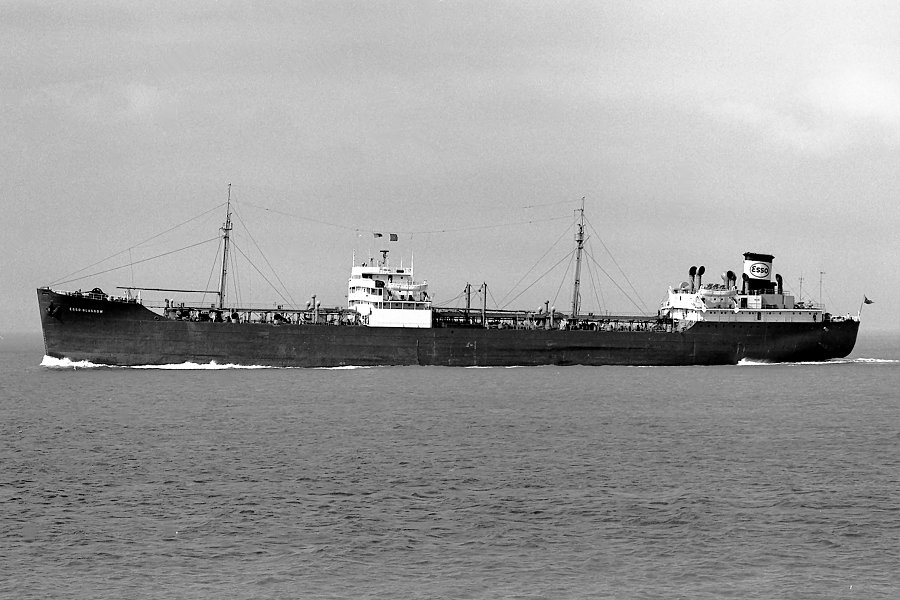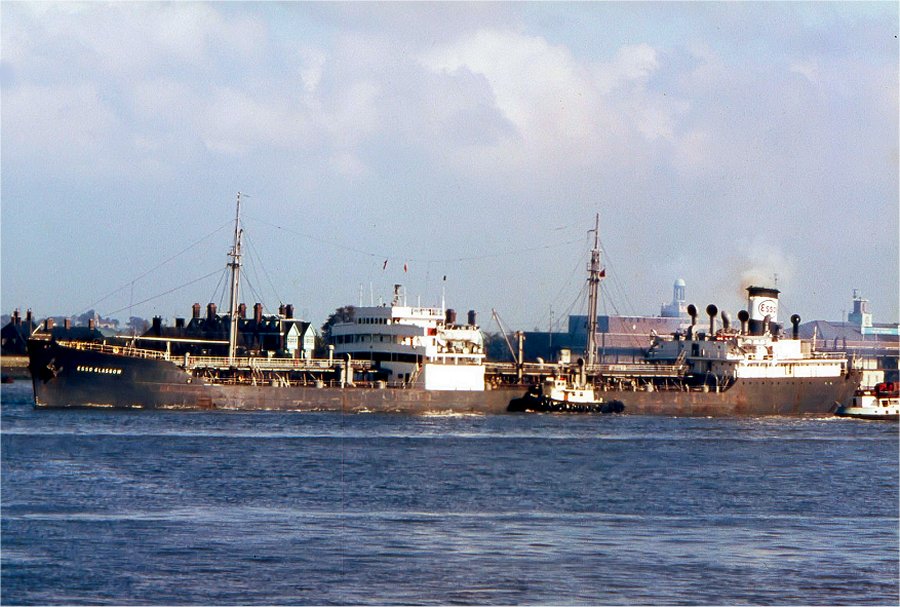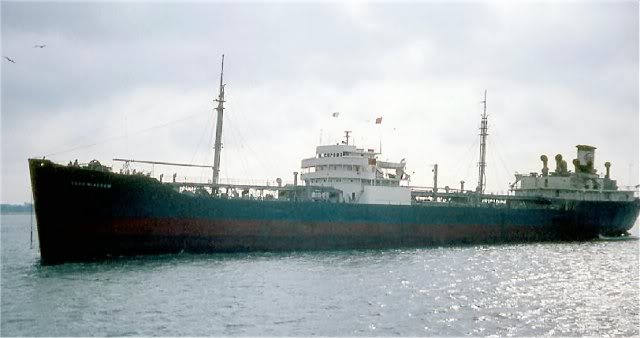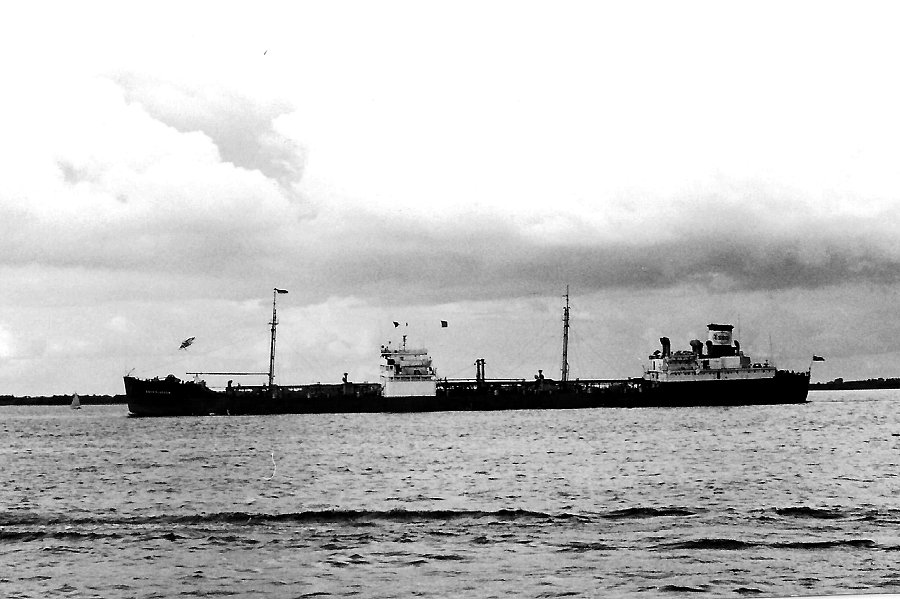Auke Visser´s Esso UK Tanker's site | home
Esso Glasgow (1947-1971)
"Esso Glasgow" was build in 1944 as "Wauhatchie" for Socony Vacuum and was renamed
and sold in 1947 to Esso UK. All photos showing her after her rebuilding in 1956.
Seen here in the location of Avonmouth, Bristol, UK.
1956 a new mid-section was built by Harland & Wolff to allow her to carry a greater number of products simultaneously.
This 310 foot section was fitted in April 1957. On 3 January 1967 Esso Glasgow suffered explosions followed by
a fire while at Fawley and was repaired at Rotterdam.
( Photo Copyright Chris Howell )
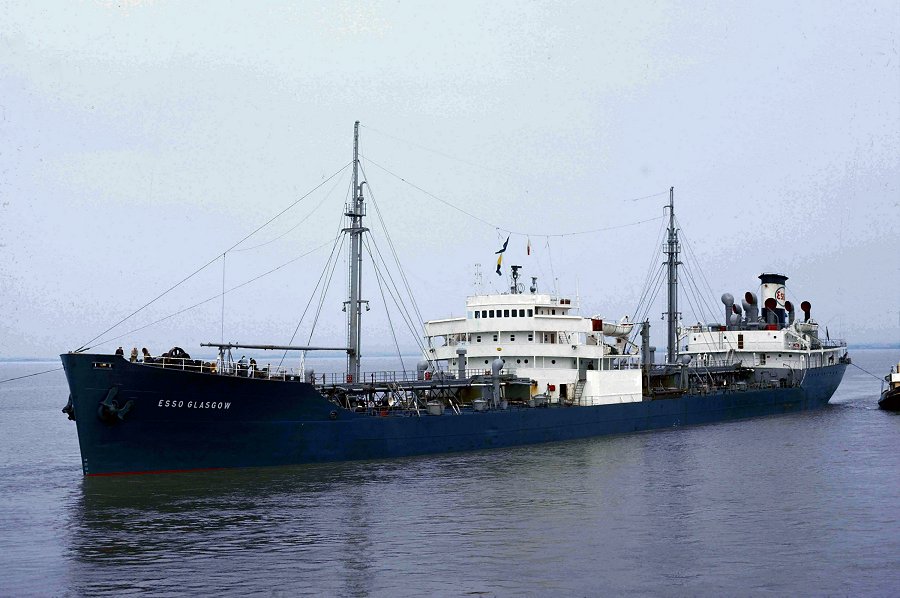
"Esso Glasgow".
( Photo Copyright Ken Smith )

( Photo Copyright K. Schemkes/DSM )
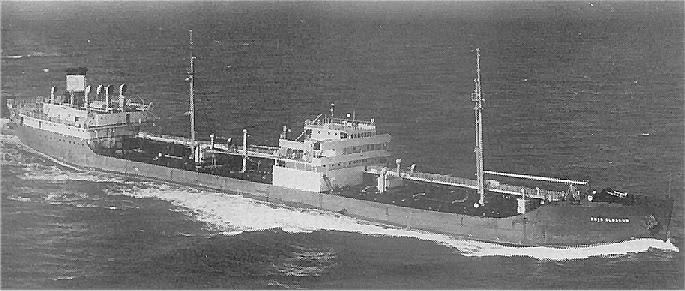
"Esso Glasgow".
"Esso Glasgow".
( Photo Copyright Ted Ingham )
"Esso Glasgow".
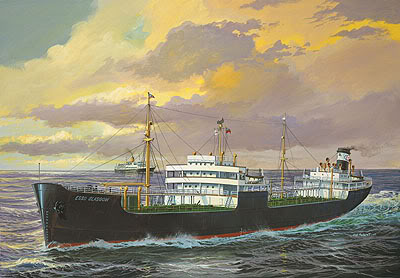
( Painting by Olaf Rahart, Maritime Painter )
This painting is a cover on a box of the model kit of the "Esso Glasgow", bij REVELL.
This model-kit, can also be used for other T2-tankers !!!!
Waterline ( Ballast) model, scale 1 : 400. Kitnumber : 05221 Oil Tanker "(Esso) Glasgow".
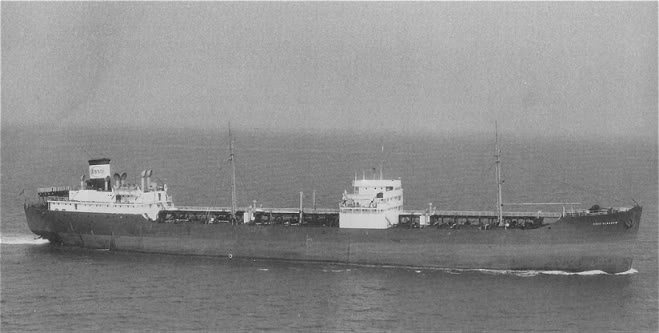
"Esso Glasgow".
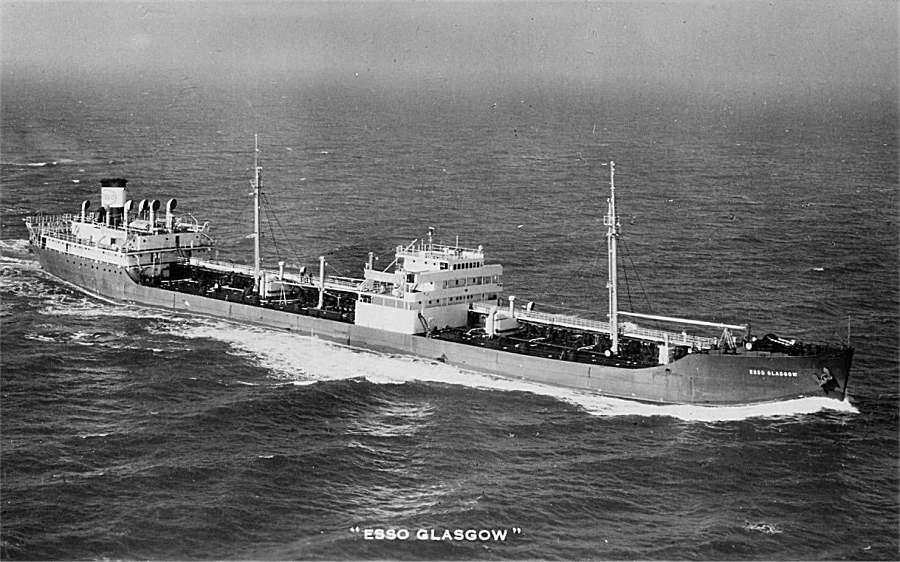
"Esso Glasgow".
"Esso Glasgow".
"Esso Glasgow".
"Esso Glasgow".
"Esso Glasgow", ex. "Wauhatchie".
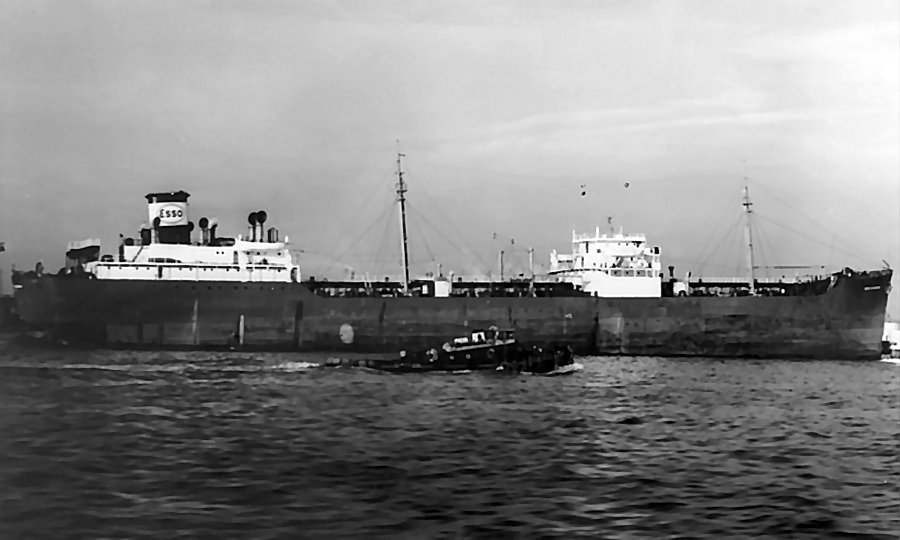
T2-SE-A1
Built December 1944 by Sun Shipbuilding Company, Chester, Pennsylvania,
as "Wauhatchie" # 1785, for U.M.S.C.
1944 : "Wauhatchie", Socony Vacuum.
1947 "Esso Glasgow", Anglo-American Oil Co., Ltd., London.
1957: New midship section built and fitted by Harland & Wolff, LTD., Belfast, to carry a number of different
grades of fuel. Used for coastal work. Old midship section was scrapped, Faslane in March 1957.
1971: Scrapped Bilbao, Spain in October 1971.
( See photos below )
The Miramar Ship Index for
|
WAUHATCHIE
|
IDNo / IMO
|
5107475
|
Year
|
1944
|
Name
|
WAUHATCHIE
|
Flag
|
USA
|
Owner
|
U.S. Government
|
Type
|
Tanker
|
Tons
|
10296
|
DWT
|
16613
|
LOA
|
159,60
|
LPP
|
153,30
|
Beam
|
20,70
|
Draft
|
9,20
|
Machenery
|
1TE-15
|
ShipDesign
|
T2-SE-A1
|
Builder
|
Sun
|
Yard
|
Chester, Pa
|
Yard No
|
452
|
Country built
|
USA
|
Keel
|
05.08.1944
|
Launch
|
14.11.1944
|
Completed
|
27.12.1944
|
Subsequent History
|
1946 ESSO GLASGOW - Anglo-American Oil
1946 ESSO GLASGOW - Esso Petroleum Co., Ltd.
1957 new cargo section fitted. Old midship section was scrapped, Faslane in March 1957.
|
End
|
1971
|
Disposal Data
|
Scrapped at Bilbao 18.07.1971. [ By Hierros Ardes ]
|
Maritime Administration Cards:

John Kirkham wrote about the "Esso Glasgow" the folowing;
ESSO GLASGOW
Built by Sun Shipbuilding and Drydock Co, Chester, PA and launched prior to 1/12/ 1944, as “WAUHATCHIE” for Socony Vacuum
(one of 198 built by Sun to the wartime T2-SE-A1 design), she was registered in Philadelphia and bought by Esso Petroleum Co,
London, on or about 1/1/1947, and renamed “ESSO GLASGOW”. Yard Number 452. USMC Number 1785, Lloyds Number 5107475.
Call Sign GTXC.
The ship was 523 feet long, 68 feet abeam and had a gross tonnage of 10448, 16613 tons deadweight, 6120 tons net.
Displacement was about 21880 tons. The turbo-electric propulsion system comprised a steam turbine of 7420 shaft horsepower from two water tube boilers, which drove a 5400kw generator to turn the propeller. The propulsion machinery was built by General Electric, Lynn, MA. Top speed was 13.75 knots; range 12,600 miles. She had two pumprooms, one forward and one aft, the latter contained 6 pumps, 3 of which were large capacity of 2000 gallons per minute.
She had 9 sets of cargo tanks. Tanks 2 through 9 had a main centre tank carrying 391,500 gallons, and 2 side tanks carrying about
165,000 gallons each. Tank 1 consisted of 2 side by side tanks, divided by a common bulkhead. Her 26 cargo tanks totalled 791898
cubic feet. Cargo capacity was about 5,930,000 gallons, 141,200 barrels. There was also a compartment for dry cargo of 15,200
cubic feet located forward of number 1 tank.
In 1956 it was decided that her tanks and midships section should be renewed to equip her for her new role in life and she arrived
at the Belfast shipyard of Harland and Wolff Ltd on 14/2/1957. Her new centre section (of the same length as the original - 310ft,
which was laid down in December 1956) was launched at Belfast on 14/3/1957 and fitted in April. Her old centre section was sold
to Shipbreaking Industries at Faslane and towed there from Belfast, arriving there on 8/3/1957.
After conversion, she sailed for sea trials 10/8/57 and then entered the Esso coastal trade. Her conversion allowed her to carry a
multitude of grades of refined product - naphtha, paraffin, white spirit, marine diesel, gas oil and petrols, generally between the refineries
at Milford Haven and Fawley and the distribution terminals at Grangemouth, Tyneside, Salt End, Purfleet, Avonmouth, Dingle and Bowling.
Whilst inbound to Salt End from Thames Haven on 12/1/1963, she was in collision in a snowstorm in the River Humber, 1.5 miles SW of Chequer Light float, 2.7 miles West South West of the Spurn light vessel, with a local pilot cutter “J.H.FISHER”, 461grt, which was holed, portside, in the engine room. The cutter sank within two hours, though without loss of life. The cutter`s crew took to their boats and life rafts but were taken aboard “ESSO GLASGOW” soon afterwards, although the Humber lifeboat was launched.
Explosion on the "Esso Glasgow", 1967.
On 4/1/1967 she caught fire after an explosion whilst berthed at No 2 jetty, Fawley refinery. The explosion occurred shortly before midnight as she was loading. There was a second explosion at 1.15 a.m. and several of the 160 firemen who fought the blaze were injured, though none seriously. No members of the crew were injured, although her Captain (H.W.Keeble) and 40 others had been on board at the time.
The Port of Southampton was closed for the night as a precaution but reopened on 5/1/1967. Other vessels berthed nearby were moved away. There was no damage to the refinery or other facilities, nor any reported spillage of oil. The fire was extinguished by 3.45 a.m.
Examination of the damage revealed that the explosion had occurred in No 6 centre tank, containing marine diesel oil, of which she had been loading four grades at the time.
She had on board 11-12000 tons of diesel and had a further 3-4000 tons to load at the time of the incident.
The damage report showed severe damage to Nos. 5,6 and 7 tanks and internal bulkheads and decking. There was a 3 feet deep split to No 6 port tank, which was exposed to the weather. After discharge of her cargo, she was moved to Cowes Roads on 6/1/1967 and then to Husbands Shipyard, Marchwood, Southampton on 9/1/1967 for temporary repairs to be carried out. She sailed to Rotterdam on 17/1/1967 for full repairs at the Wilton Fijenoord yard, arriving at Nieuwe Waterweg on 19/1/1967.
Prior to purchase by Esso UK, she was a regular visitor to UK; her earliest visit was to Swansea on 28/12/1944, when new. She also
visited Milford Haven, Thames Haven, Avonmouth, Barry Island, Sunderland, Liverpool and Isle of Grain. Her service with Socony
Vacuum and Esso UK prior to her 1957 conversion was deep sea, carrying crude oil from point of export to UK and elsewhere.
“ESSO GLASGOW” was the last of the nine wartime T2 tankers acquired by Esso to remain in the fleet, the others having been
disposed of in the late 1950s and early 1960s. She owed her longevity to her conversion for coastwise operations in 1957.
Her long and eventful career ended in 1971 when she was sold for scrap to Spanish shipbreakers at Bilbao, her duties having been taken over by new build tonnage. The decision to scrap her was announced in Lloyd`s List on 6/7/71, for the price of £17 per light ton displacement.
Her final movements according to Lloyd`s are ;
30/6/1971 sailed Fawley
1/7/1971 arrived Salt End
2/7/1971 sailed Salt End
3/7/1971 arrived Fawley
4/7/1971 sailed Fawley
5/7/1971 arrived Milford Haven
5/7/1971 sailed Milford Haven
6/7/1971 arrived Avonmouth
7/7/1971 sailed Avonmouth
??/7/1971 arrived Fawley
10/7/1971 sailed Fawley
12/7/1971 in the River Thames
13-16/7/1971 Esso jetty, Purfleet
16/7/1971 sailed London
18/7/1971 arrived Bilbao, under her own power
The ship was originally named for the Battle of Wauhatchie, which took place near Chattanooga, TN on 29/10/1863.
This was a rare night attack, by the Confederates under Gen. Micah Jenkins on the Union corps of Gen. John W. Geary.
The Union successfully repulsed the onslaught though 78 men were killed. Confederate losses amounted to 34 dead.
History and notes :
1957: New midship section built and fitted by Harland & Wolff, LTD., Belfast, to carry a number of different grades of fuel.
Used for coastal work. Old midship section was scrapped, Faslane in March 1957.
Esso Glasgow was scrapped Bilbao, Spain in October 1971.
Source:
Victory Ships and Tankers
Originally there were 4 electric cargo pumps that were driven by the main generator, which could be disconnected electrically from the main propulsion motor. The motors were in the engine room, and the shaft to the centrifugal pumps passed through the forward engine room bulkhead into the pump room. This system worked very well. However, the cargo pumps on the refurbished Esso Glasgow were duplex steam reciprocating engines, which were designed as vertical steam pumps but were installed horizontally ! They were a problem every time they were used !
In December 1959 the Esso Glasgow, which had just loaded with aviation fuel in Galveston, Texas, was sailing at a slow speed down the Houston Ship Channel in thick fog. An empty American tanker came up the Channel at high speed, and hit the Esso Glasgow, causing it to turn around in the Channel. There was damage to the bows, and as there was no room to turn around safely the ship had to go astern all the way to Houston, where emergency repairs were made prior to sailing for Purfleet, on the Thames Estuary in the UK.
Source: Provided by Ken Philp on 10 December 2005.
|
